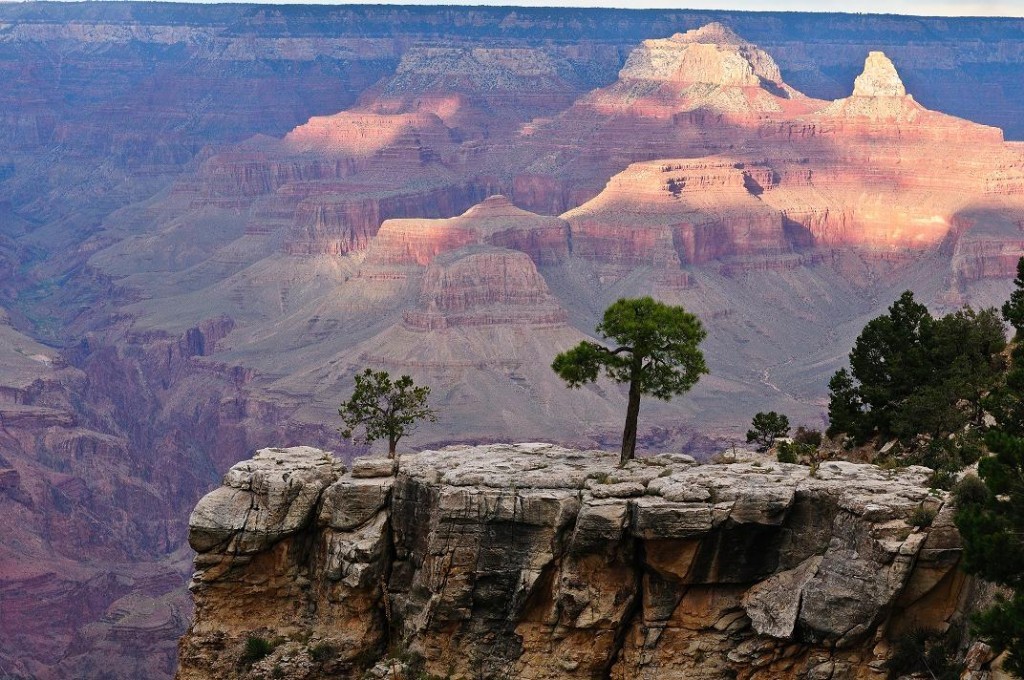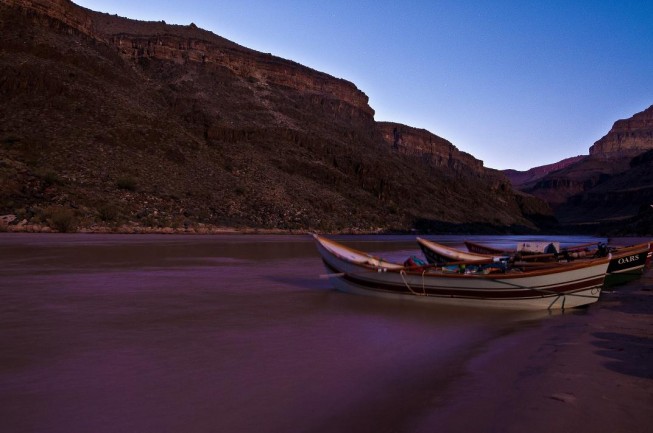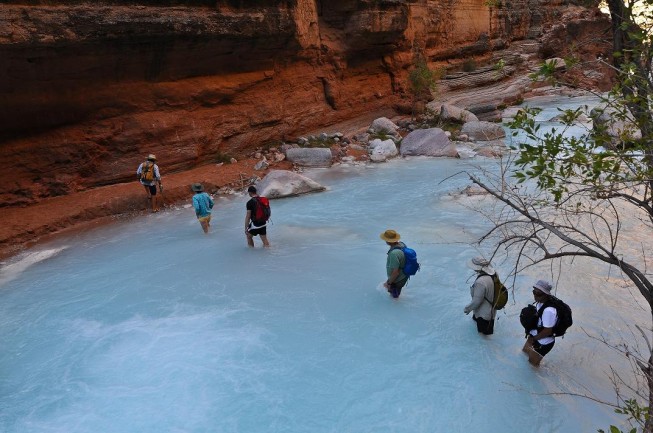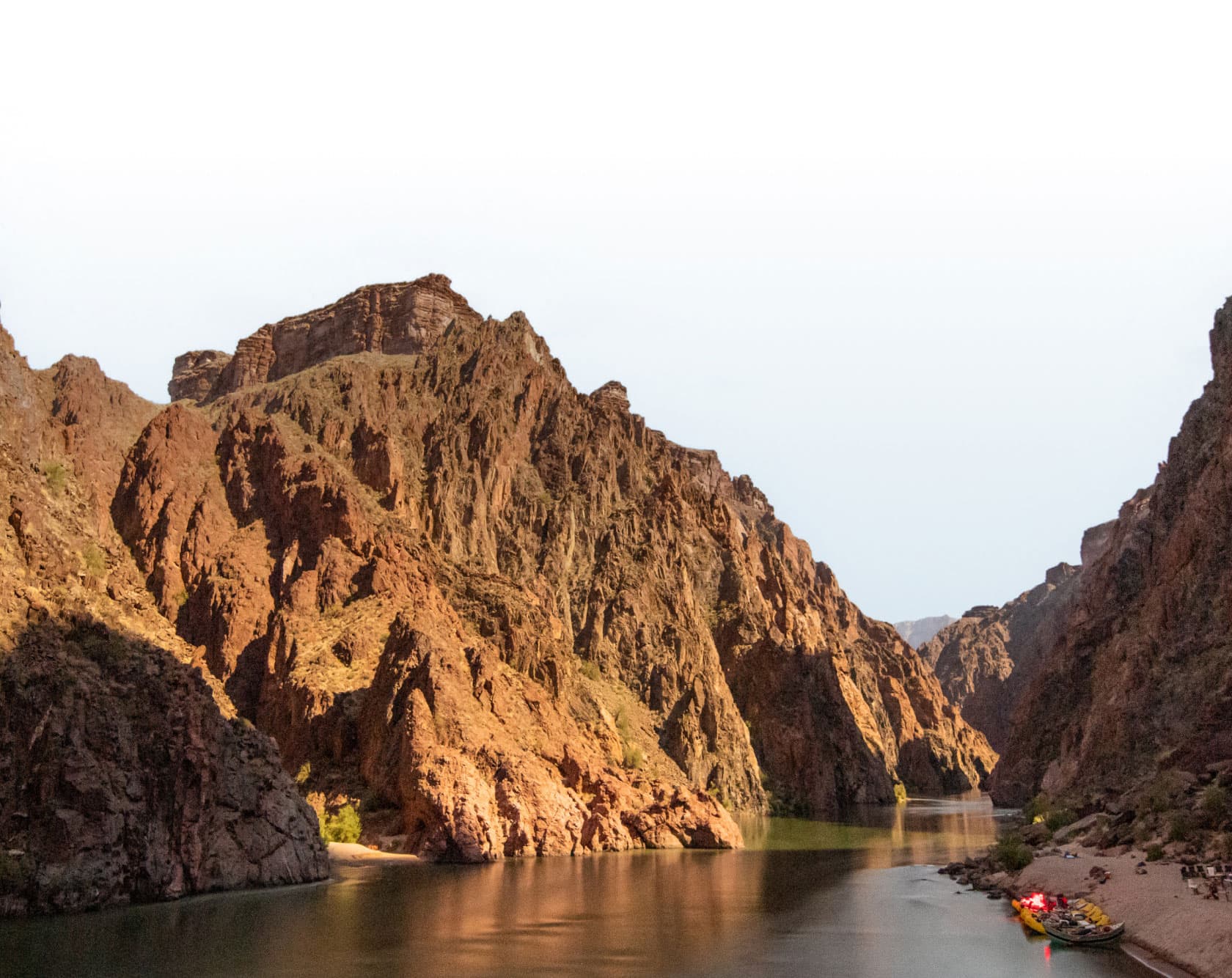The Heart of the Grand Canyon


Stars collided far above the imposing wall of granite cliffs, while soft moonlight danced across the ripples of the river. At a distance, the rush of rapids offered a soothing, synchronized chorus, as the muted colors of our little dories reflected off the riverbank.
Sitting on a sandy stretch of Crystal Beach, in the deepest recesses of Arizona’s incomparable Grand Canyon, we listened to the poem, “SAND,” by Peter Goodwin, a fellow traveler from New York who had written it while the rest of us were busy pitching tents. As the sun set on another wondrous day on the river, my mind fixed on the inadequacy of the word “beautiful” to describe this remote and remarkable place, the relevance of the just-penned poem, and the sheer majesty of all that surrounded us.
I’ve had it with this Grand Canyon
nothing but rock and sand
the rocks up there
the sand down here
In my shoes, between my toes
in the tent and sleeping bag
everywhere
even in my coffee cup.
Next time, Mr. Boatman, please
find us a campsite without sand
a nice meadow will be fine
soft, sandless and green
and while you are about it
a hot shower would be nice
and maybe an electric outlet…
—Peter Goodwin
Visiting the Grand Canyon was a dream I had pursued for years. Then, a friend had suggested if I ever realized my dream, I shouldn’t confine myself to the “rims,” but venture deep into the canyon via a dory on the Colorado River. Following a flood of email exchanges, I signed up for a trip that combined the adrenalin rush of running full-on rapids with a personal test of physical endurance.
The October morning sun had yet to emerge from the horizon, when we stood at the Bright Angel Trailhead on the canyon’s South Rim pondering the trek that lay before us: a 7.7-mile descent into the depths of the canyon to the river. It’s a hike that can test the mettle of any man but we were prepared. Day packs laden with water, snacks, cameras and sunscreen, we had been warned, advised and provided with all possible lessons of survival.
As the morning progressed and the hike stretched into miles, I found solace in the sparse desert vegetation that littered the canyon floor – Sonoran oak and brittlebush, sun-soaked shrubs and flowering daisies.
“Oh, it’s not too far, you are almost there,” fellow hikers intoned along the route. While the morning air started out cool, my energy levels were gradually sapped by the increasing heat of the day and I felt a real sense of accomplishment when we finally arrived at Pipe Creek. After a brief rest, we stored our personal gear away in water-tight hatches, donned our lifejackets, boarded our boats and headed out into the ambling current.
Our party consisted of four dories, four guides, two assistants and 11 enthusiasts. I was on a 12-day, 137-mile trip down the Colorado River from Pipe Creek to Diamond Creek—the most dramatic stretch of the river—and it didn’t take long to feel relaxed and cooled by the river.
In just four hours, my previously crumbling body filled with aches and pains had been rejuvenated. Looking above at the massive cliffs and the rapidly moving white clouds sandwiched between the red sandstone and the brilliant blue sky, I realized this was the Grand Canyon I had waited to see for so long.
It takes a team to run the river and OARS has mastered it to the last half-hitch.
First, the river guides—my group with Steve Kenny, Duffy Dale, Elena Kirschner and leader Nick Grimes—were a hardy lot. It requires a special persona and a little wild streak to do this job. It was demystifying to know that river guides don’t just row. They make traveler’s lives on the river easier in every possible manner. They cook, pack, wash, entertain, tell us stories, sing and dance, and ensure the safety of their entire entourage.
Each day, we spent three to five hours on our small boat. Then we’d find a little patch of sand that became our home for the night. Loading and unloading a dory and back-up raft is an art perfected by every boatman. Giant coolers carrying perishable items, folding tables, chairs, pots and pans, ample beer, emergency kits, and even a portable toilet are all unpacked and repacked at every camp.

Eleven of us from Germany, France, India and the USA, age 30 to 70, crammed into the small wood and fiberglass boats: two in the front, one in the back, and our boatman in the center. On the river, our guides told of the canyon’s history and mystery, imparted legend and lore, pointed out natural phenomena of the canyon and wildlife, and occasionally warned us of impending rapids.
Crossing each rapid is a mix of art and science. As we approached the rapid, instructions were called out: move to the right, helmets on, sit straight. It’s all about the 10-16 seconds of escaping the churning waters without flipping the boat. Once cleared, baling began, as guides checked the safety of other boats. Every rapid is a challenge that requires strategy and precision.
Along the banks, vegetation surprises first-timers. The Grand Canyon’s isolation, elevation, and position at the convergence of the Mojave, Sonoran and Great Basin deserts—have created unique habitats for an unusual assemblage of plants. Some grow only at seeps and springs, while others emerge from cracks in the bedrock. Some species live only in the Grand Canyon.
Experiencing the heart of the Grand Canyon is not solely about floating on dories, however. It is the entirety of the experience—the tall tales, personal challenges, camaraderie, ever-changing vistas, and the remarkable stories of human history that complete the trip.
With the coming day, a conch shell signal would alert the party that a new dawn was rising and we were ready to roll. Each evening, as we pulled into secluded beaches, we would discover a new world. Under clear skies speckled with countless stars, we dined on delicacies as fine as any resort cuisine. And we found contentment in a perfect balance of sun and sand and sky, and just the right mix of traveling companions.
When we reached Lava Falls, everything came together. We had crossed Hermit, Granite and Crystal rapids where we got pushed and pulled, lost an oar, hit a rock and dented the boat, but we sailed through without being swallowed by the river. Lava was decidedly different. It’s dynamic, dramatic and powerful waves created anxiety in each of us even before we had glimpsed our first whitewater.
Duffy Dale, my new friend and boatman, sidled up to me and pointed to a place on the top of the cliff.
“That’s where I got married, directly below the Lava,” Duffy said. Duffy had lost count of how many times he had crossed this treacherous stretch of the Colorado River—over a hundred? Yet, every single crossing is different. After a 15-minute strategy session replete with drawings in the wet sand, he outlined the run and gave his three passengers confidence and direction. Everyone nodded, while most said a silent prayer. Before climbing aboard the dory, Duffy offered one last piece of advice: “If the boat tips, hold onto the rope line.” We all said a second silent prayer.
With so much experience, Duffy went first. In the next 16 seconds, our dory hit the first wave hard, and the second wave bulldozed us from the left. Duffy saw a 15-foot wall of water approaching from the bow and pulled hard to avoid it, allowing us to punch through to the right. We exited the rapid with a boat completely filled with water, but still stable enough to make it downstream to Tequila Beach. We watched as the other boats successfully negotiated the rapids. Then, we screamed, hugged, high-fived, and scrambled around for a cold beverage.

The magic of a dory trip can’t be matched by any other kind of visit to the Grand Canyon. Its rapids are like a roller coaster ride, while its side hikes are an exploration into the unknown. For the majority of the trip, we saw the river and the canyon walls as one color, until we reached Havasu Creek. There, the canyon’s surprises are unending. Huge canyon walls that dwarf human visitors, the small watercraft and all vegetation, are humbling. Two distinct colors of water mix together. A side hike up the creek left us all with a sense of awe.
Arriving quietly at Diamond Creek in the afternoon of our 12th day, the sight of trucks ready to retrieve our dories and all the accessories was instantly depressing.
As we loaded the boats, I suddenly didn’t want to leave. My long-ago dream of experiencing the heart of the Grand Canyon, now realized, was ending far too soon. Even now, weeks after this incredible journey, I’m reminded daily of new-found friendships, raging torrents, snippets of real danger, and fine dining, all in a land as untamed and timeless as any in the world.
I simply must go back!
This article originally appeared in the OARS 2013 catalog. Want to get your hands on a copy? Order or view the most recent edition online here: www.oars.com/catalog
Related Posts
Sign up for Our Newsletter






